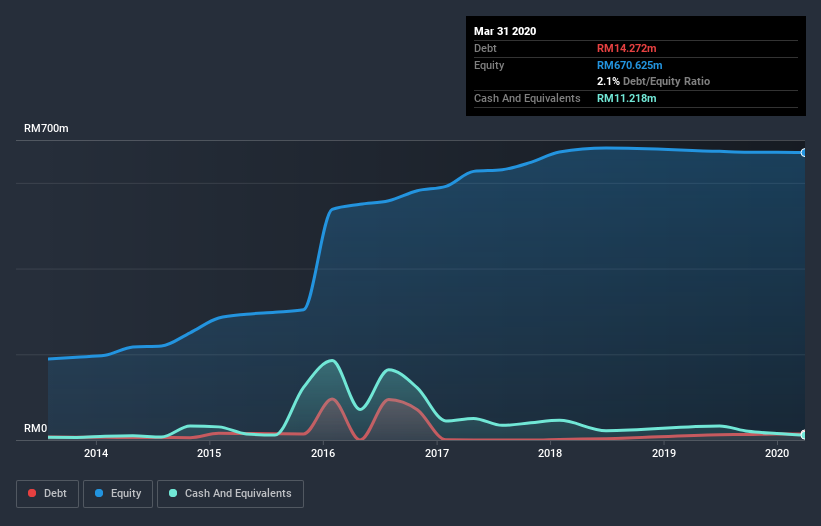- Malaysia
- /
- Hospitality
- /
- KLSE:BORNOIL
These 4 Measures Indicate That Borneo Oil Berhad (KLSE:BORNOIL) Is Using Debt Reasonably Well

Some say volatility, rather than debt, is the best way to think about risk as an investor, but Warren Buffett famously said that 'Volatility is far from synonymous with risk.' So it seems the smart money knows that debt - which is usually involved in bankruptcies - is a very important factor, when you assess how risky a company is. We can see that Borneo Oil Berhad (KLSE:BORNOIL) does use debt in its business. But the real question is whether this debt is making the company risky.
Why Does Debt Bring Risk?
Debt and other liabilities become risky for a business when it cannot easily fulfill those obligations, either with free cash flow or by raising capital at an attractive price. If things get really bad, the lenders can take control of the business. However, a more common (but still painful) scenario is that it has to raise new equity capital at a low price, thus permanently diluting shareholders. Of course, the upside of debt is that it often represents cheap capital, especially when it replaces dilution in a company with the ability to reinvest at high rates of return. The first thing to do when considering how much debt a business uses is to look at its cash and debt together.
Check out our latest analysis for Borneo Oil Berhad
What Is Borneo Oil Berhad's Net Debt?
You can click the graphic below for the historical numbers, but it shows that as of March 2020 Borneo Oil Berhad had RM14.3m of debt, an increase on RM12.4m, over one year. However, because it has a cash reserve of RM11.2m, its net debt is less, at about RM3.05m.

How Healthy Is Borneo Oil Berhad's Balance Sheet?
The latest balance sheet data shows that Borneo Oil Berhad had liabilities of RM29.1m due within a year, and liabilities of RM31.1m falling due after that. On the other hand, it had cash of RM11.2m and RM47.7m worth of receivables due within a year. So it has liabilities totalling RM1.3m more than its cash and near-term receivables, combined.
Having regard to Borneo Oil Berhad's size, it seems that its liquid assets are well balanced with its total liabilities. So it's very unlikely that the RM181.4m company is short on cash, but still worth keeping an eye on the balance sheet.
In order to size up a company's debt relative to its earnings, we calculate its net debt divided by its earnings before interest, tax, depreciation, and amortization (EBITDA) and its earnings before interest and tax (EBIT) divided by its interest expense (its interest cover). Thus we consider debt relative to earnings both with and without depreciation and amortization expenses.
Borneo Oil Berhad has net debt of just 0.23 times EBITDA, indicating that it is certainly not a reckless borrower. And it boasts interest cover of 8.8 times, which is more than adequate. In addition to that, we're happy to report that Borneo Oil Berhad has boosted its EBIT by 74%, thus reducing the spectre of future debt repayments. The balance sheet is clearly the area to focus on when you are analysing debt. But it is Borneo Oil Berhad's earnings that will influence how the balance sheet holds up in the future. So when considering debt, it's definitely worth looking at the earnings trend. Click here for an interactive snapshot.
Finally, while the tax-man may adore accounting profits, lenders only accept cold hard cash. So the logical step is to look at the proportion of that EBIT that is matched by actual free cash flow. Over the last three years, Borneo Oil Berhad saw substantial negative free cash flow, in total. While investors are no doubt expecting a reversal of that situation in due course, it clearly does mean its use of debt is more risky.
Our View
The good news is that Borneo Oil Berhad's demonstrated ability to grow its EBIT delights us like a fluffy puppy does a toddler. But the stark truth is that we are concerned by its conversion of EBIT to free cash flow. All these things considered, it appears that Borneo Oil Berhad can comfortably handle its current debt levels. On the plus side, this leverage can boost shareholder returns, but the potential downside is more risk of loss, so it's worth monitoring the balance sheet. There's no doubt that we learn most about debt from the balance sheet. However, not all investment risk resides within the balance sheet - far from it. Take risks, for example - Borneo Oil Berhad has 3 warning signs (and 1 which doesn't sit too well with us) we think you should know about.
If, after all that, you're more interested in a fast growing company with a rock-solid balance sheet, then check out our list of net cash growth stocks without delay.
When trading Borneo Oil Berhad or any other investment, use the platform considered by many to be the Professional's Gateway to the Worlds Market, Interactive Brokers. You get the lowest-cost* trading on stocks, options, futures, forex, bonds and funds worldwide from a single integrated account. Promoted
Valuation is complex, but we're here to simplify it.
Discover if Borneo Oil Berhad might be undervalued or overvalued with our detailed analysis, featuring fair value estimates, potential risks, dividends, insider trades, and its financial condition.
Access Free AnalysisThis article by Simply Wall St is general in nature. It does not constitute a recommendation to buy or sell any stock, and does not take account of your objectives, or your financial situation. We aim to bring you long-term focused analysis driven by fundamental data. Note that our analysis may not factor in the latest price-sensitive company announcements or qualitative material. Simply Wall St has no position in any stocks mentioned.
*Interactive Brokers Rated Lowest Cost Broker by StockBrokers.com Annual Online Review 2020
Have feedback on this article? Concerned about the content? Get in touch with us directly. Alternatively, email editorial-team@simplywallst.com.
About KLSE:BORNOIL
Borneo Oil Berhad
An investment holding company, operates and franchises fast food restaurants in Malaysia and Australia.
Low with imperfect balance sheet.

